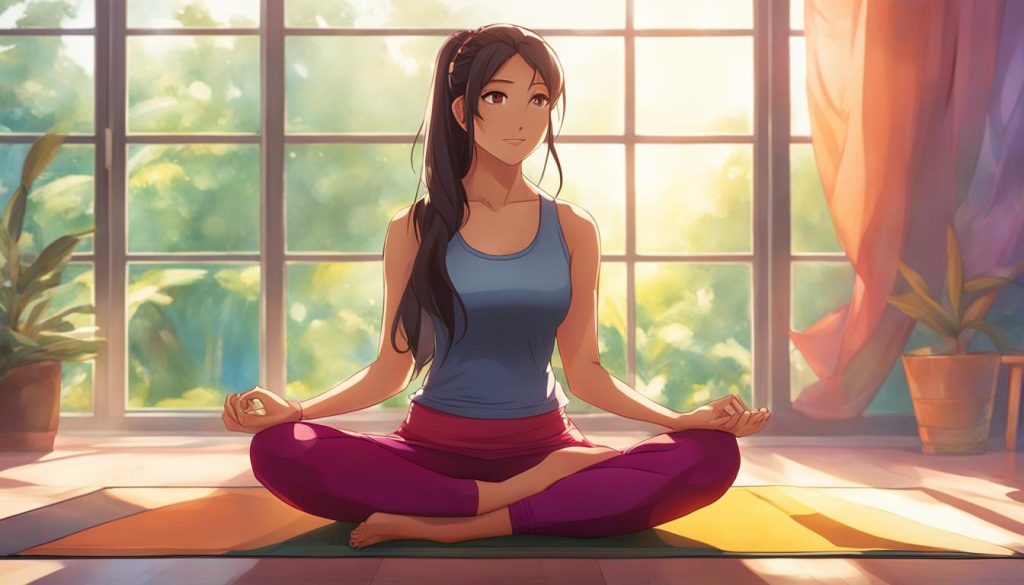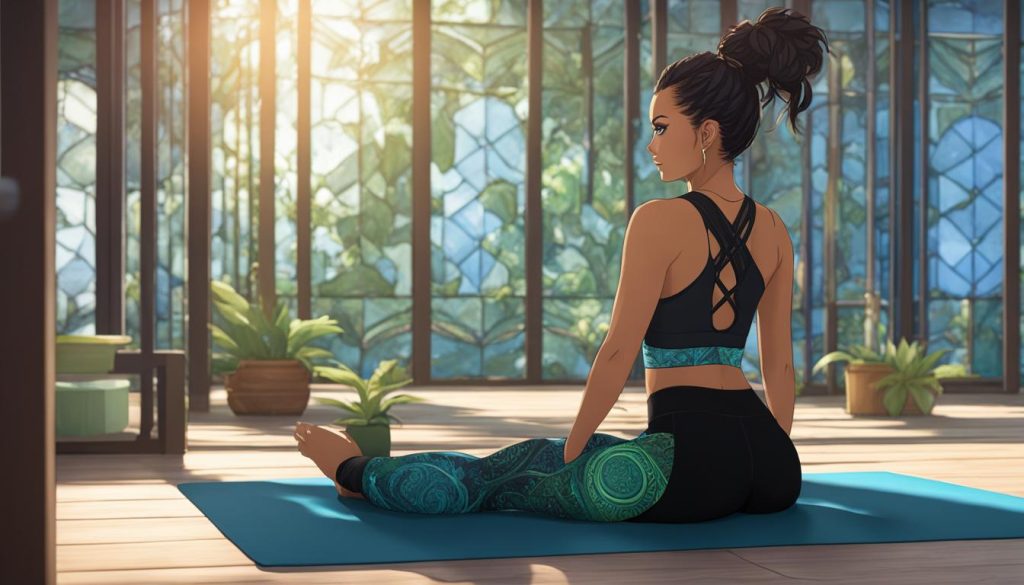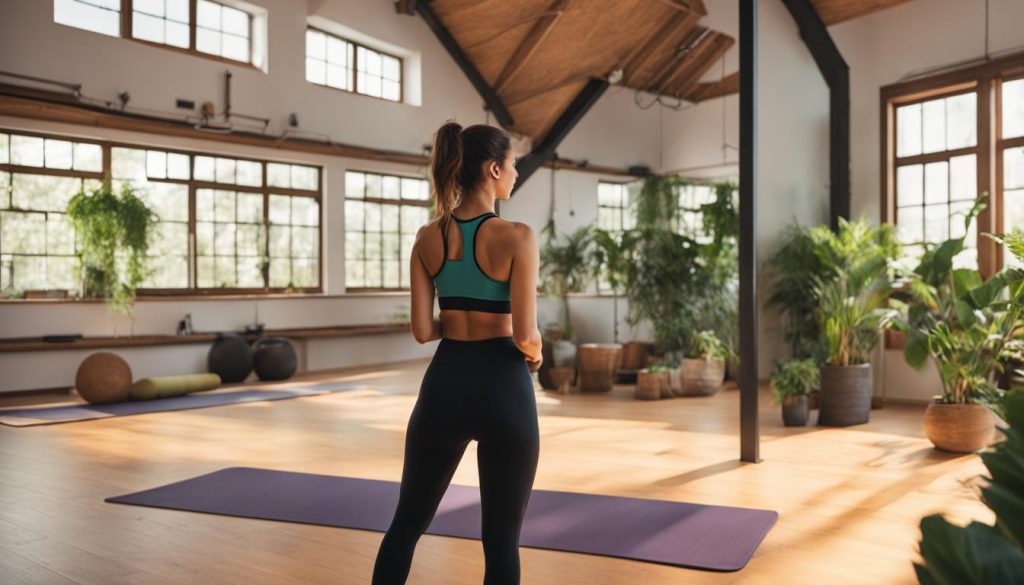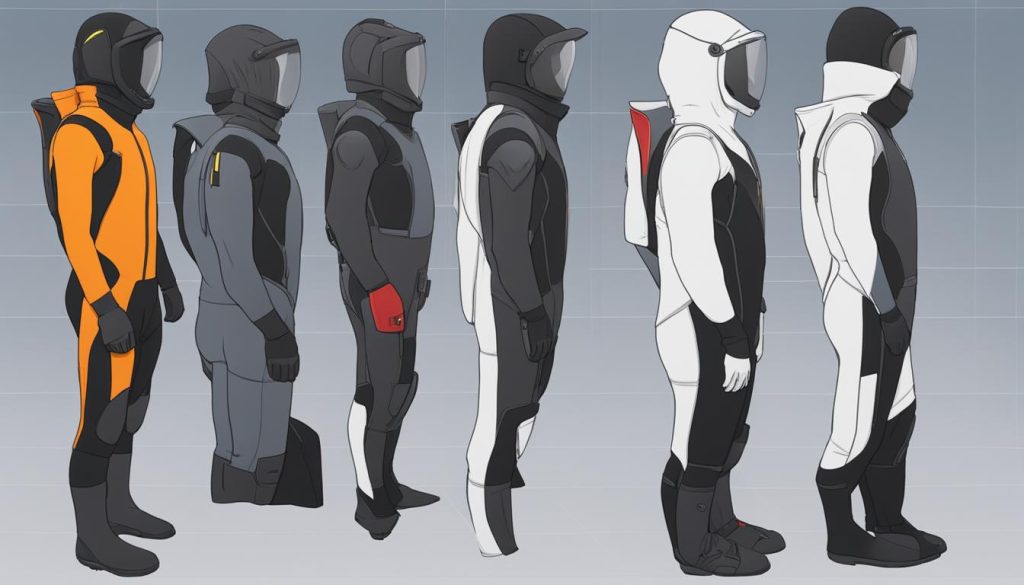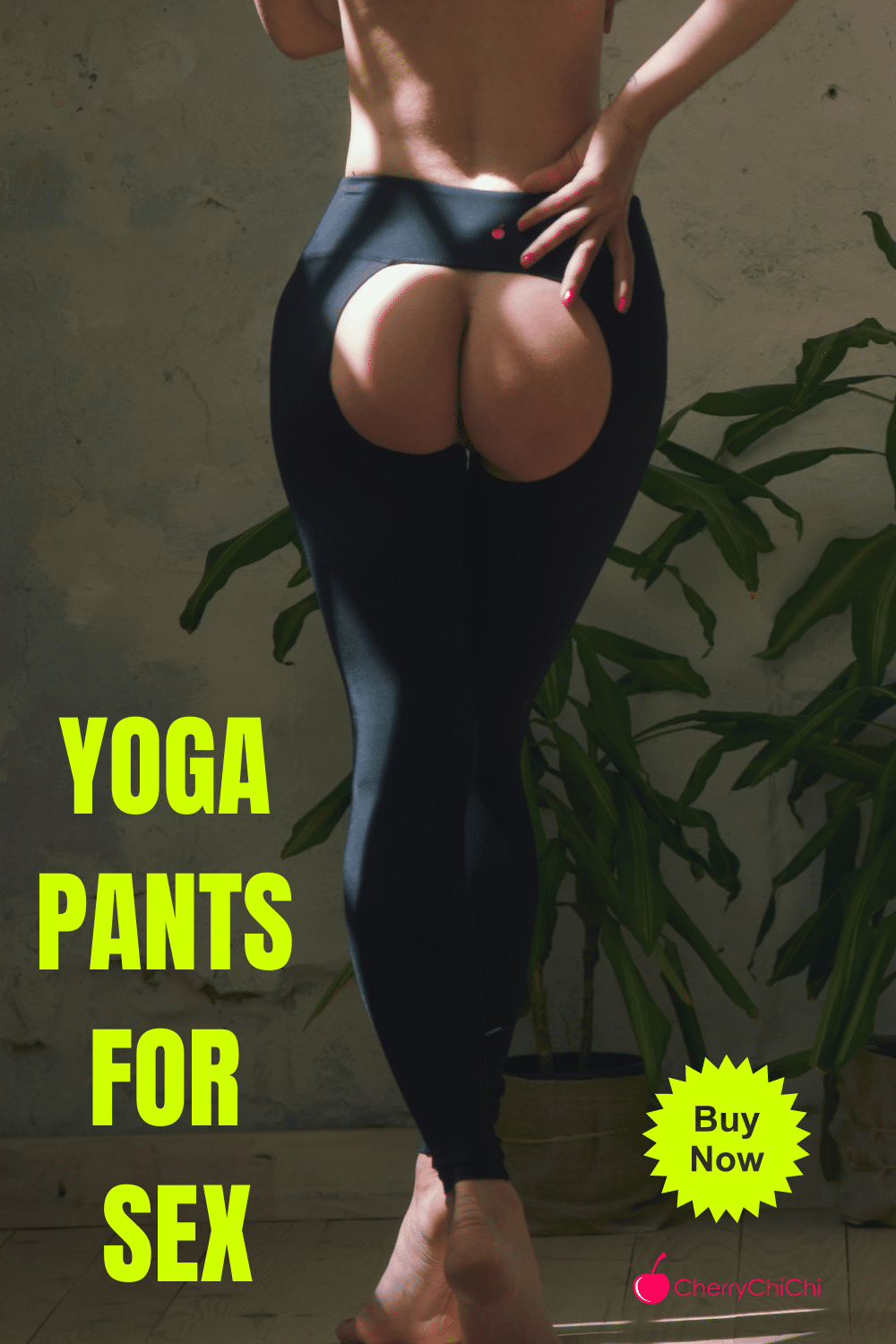
When it comes to yoga and swimming, choosing the right attire is essential for comfort and performance. Many yoga enthusiasts wonder if they can use their yoga pants for swimming. In this guide, I will provide you with all the information you need to know about using yoga pants for aquatic activities and suitable swimwear for yoga.
Key Takeaways:
- Yoga pants can be a suitable option for swimming due to their quick-drying and stretchy fabrics.
- Consider the specific type of yoga pants and their water-friendly properties before using them for swimming.
- Choose swimwear that fits comfortably and allows for ease of movement during yoga and swimming activities.
- Avoid wearing swimwear or underwear to your yoga class and opt for yoga-specific clothing.
- Select clothing made of breathable and moisture-wicking fabrics to stay comfortable during your practice.
What To Wear to Yoga: 4 Top Tips
When it comes to practicing yoga, choosing the right attire is essential for a comfortable and enjoyable experience. Here are four top tips to help you dress appropriately for your yoga sessions:
1. Opt for Comfortable Yoga Clothing
When selecting your yoga outfit, prioritize comfort above everything else. Look for clothing made from soft, breathable fabrics that allow for ease of movement. Avoid tight, restrictive clothing that may hinder your flexibility. Opt for yoga pants or leggings that provide a good range of motion and a supportive sports bra that offers comfort and stability.
2. Choose Clothing Suitable for Your Yoga Practice
Consider the type of yoga practice you will be doing and choose your clothing accordingly. If you will be practicing hot yoga or Bikram yoga, opt for moisture-wicking fabrics that will keep you cool and dry. If you prefer a more gentle or restorative style of yoga, choose loose-fitting clothes that allow for relaxation and comfort.
3. Dress in Layers
Layering your yoga clothing can be helpful, especially if you’re practicing in a cooler environment or during colder seasons. Start with a lightweight, breathable base layer that wicks away moisture. Add a long-sleeved shirt or a warm sweater for added warmth. This way, you can easily adjust your clothing according to your body temperature during your practice.
4. Focus on Comfortable Footwear
In most yoga practices, bare feet are preferred to establish a strong connection with the ground and enhance balance. Avoid wearing shoes during your yoga sessions, as they can restrict your movements and stability. If you prefer to have some foot support, opt for yoga socks with non-slip soles.
By following these four top tips, you can ensure that you are dressed appropriately for your yoga practice, allowing for comfort, freedom of movement, and a fulfilling experience.
| What to Wear | What Not to Wear |
|---|---|
|
|
What To Wear to a Yoga Class: Yoga Outfit Ideas
When it comes to choosing the perfect yoga outfit, there are a few options to consider. Yoga pants are a staple in many yogis’ wardrobes, providing comfort and flexibility. Pair them with a supportive sports bra and a fitted yoga top for a stylish and comfortable outfit. Don’t forget to bring your own yoga mat to class for added comfort and hygiene.
Yoga Pants:
| Style | Description | Features |
|---|---|---|
| High-Waisted | Provides extra coverage and support around the waist. | Wide waistband, moisture-wicking fabric |
| Capri | Offers a shorter length for better airflow. | Stretchy fabric, wide range of colors |
| Bootcut | Flares out slightly at the bottom for a flattering look. | Flattering silhouette, stretchy and breathable fabric |
Sports Bras:
- Choose a sports bra that offers the right level of support for your yoga practice.
- Look for features like adjustable straps, moisture-wicking fabric, and removable padding.
- Opt for a style that provides comfort and freedom of movement without compromising support.
Yoga Tops:
“I love wearing lightweight, breathable yoga tops during my practice. They allow me to move freely and keep me cool throughout my yoga session.” – Yoga enthusiast
When selecting a yoga top, consider the following:
- Choose a breathable fabric that wicks away sweat.
- Look for tops with built-in bras for added support.
- Opt for styles that allow for a wide range of movement, such as racerback or scoop-neck designs.
By wearing comfortable and functional yoga outfits, you can fully focus on your practice and enjoy all the benefits that yoga has to offer. Remember to choose clothing that allows for ease of movement, provides support where needed, and enhances your overall yoga experience.
What to Wear to Hot Yoga Classes
When attending hot yoga classes, it’s essential to choose the right attire that will keep you cool and comfortable during intense heat. The combination of high temperatures and vigorous movements requires breathable fabrics and moisture-wicking clothing to help regulate your body temperature and prevent discomfort.
Opt for lightweight tops made from materials such as nylon or polyester, which are known for their quick-drying properties. These fabrics allow for better air flow, keeping you cool as you move through your yoga practice. Pair your top with shorts or capri leggings made from similar moisture-wicking materials to ensure maximum comfort.
A sports bra is also a great choice for hot yoga classes, providing the necessary support while allowing your skin to breathe. Look for sports bras made from breathable fabrics like nylon or spandex, with features such as mesh panels or moisture-wicking capabilities.
“Choosing the right attire for hot yoga classes is crucial for your comfort and performance. Opt for breathable fabrics and moisture-wicking clothing to stay cool and prevent discomfort in intense heat.”
In addition to choosing the right clothing, it’s important to stay hydrated during hot yoga classes. Remember to drink plenty of water before, during, and after your practice to replenish fluids lost through sweat. And don’t forget to bring a towel to wipe away any excess sweat during the class.
Table: Comparison of Hot Yoga Attire
| Attire | Features | Benefits |
|---|---|---|
| Lightweight Tops | – Quick-drying materials – Breathable fabrics – Allows better air flow |
– Keeps you cool during intense heat – Reduces discomfort caused by sweat |
| Shorts or Capri Leggings | – Moisture-wicking properties – Breathable materials |
– Provides freedom of movement – Helps regulate body temperature |
| Sports Bras | – Breathable fabrics – Mesh panels or moisture-wicking capabilities |
– Provides support while allowing the skin to breathe – Reduces chafing and discomfort |
By choosing the right hot yoga attire, you can enhance your overall experience and focus on your practice without being distracted by discomfort or excessive sweating. Remember to listen to your body and take breaks as needed to prevent overheating. Enjoy your hot yoga sessions and embrace the challenge of practicing in the heat!
How to Choose the Right Workout Clothes
When it comes to selecting workout clothes, it’s important to consider both the fabric and fit to ensure maximum comfort and performance. The right workout attire can make a significant difference in your overall workout experience. Here are some key factors to keep in mind when choosing your workout apparel:
- Fabric Selection: Opt for moisture-wicking fabrics that help to draw sweat away from your skin, keeping you dry and comfortable during your workout. Look for materials such as nylon, polyester, or spandex blends that offer breathability and flexibility.
- Fit Selection: Choose workout clothing that allows for unrestricted movement and doesn’t bind or chafe. Consider the type of activity you’ll be doing and select clothing that is appropriate for that specific workout. For example, if you’ll be engaging in high-impact activities like running, opt for supportive sports bras and leggings that provide adequate coverage and compression.
- Layering: Depending on the weather conditions and the intensity of your workout, layering can be beneficial. Start with a moisture-wicking base layer that helps to regulate body temperature. Add a lightweight, breathable mid-layer for insulation, and top it off with an outer layer that protects against wind or rain.
Remember, the main goal of workout clothing is to provide comfort, freedom of movement, and support. It’s important to try on different brands and styles to find what works best for you. Investing in the right workout clothes will not only enhance your performance but also make you feel confident and motivated during your workouts.
Table: Comparing Different Workout Fabrics
| Fabric | Properties | Best for |
|---|---|---|
| Nylon | Durable, moisture-wicking, quick-drying | High-intensity workouts, outdoor activities |
| Polyester | Lightweight, breathable, moisture-wicking | Running, gym workouts |
| Spandex | Stretchy, form-fitting, allows freedom of movement | Yoga, Pilates, dance |
| Cotton | Soft, comfortable, breathable | Low-intensity workouts, casual wear |
Choosing the right workout clothes is essential for a successful workout. The fabric selection should prioritize moisture-wicking properties to keep you dry and comfortable. Additionally, the fit of your attire should allow for unrestricted movement and provide the necessary support. Layering with appropriate clothing is crucial in different weather conditions. By considering these factors and investing in the right workout clothes, you can optimize your performance and feel confident during your workouts.
What to Wear for Beach Workouts
When it comes to beach workouts, it’s important to wear attire that can withstand the elements while providing comfort and flexibility. Whether you’re engaging in yoga, running along the shore, or participating in a high-intensity interval training (HIIT) session, choosing the right beach workout attire is crucial for an enjoyable and effective workout.
Swimsuits are a popular choice for beach workouts, providing freedom of movement and allowing you to cool off in the water. Opt for sports bra bikini tops for added support and pair them with board shorts or surf leggings to protect your legs from the sun and sand. Rash guards are also a great addition, offering sun protection and preventing rashes caused by sand and friction.
When selecting beach workout attire, consider the fabric. Look for quick-drying materials that won’t weigh you down when wet. Moisture-wicking fabrics are ideal for keeping you cool and comfortable, as they draw sweat away from your skin. Additionally, choose materials that offer UV protection, such as swimwear with UPF ratings, to shield your skin from harmful rays.
Here is a suggested beach workout attire checklist:
- Swimsuit or sports bra bikini top
- Board shorts or surf leggings
- Rash guard for sun protection and preventing rashes
- Quick-drying and moisture-wicking fabrics
- Swimwear with UPF ratings for added sun protection
- Water shoes or sandals for walking on hot sand
- Sunscreen to protect exposed skin
- A hat or visor for additional sun protection
- A towel or mat for yoga or stretching exercises
By dressing appropriately for your beach workouts with the right attire, you can fully enjoy the serenity of the ocean while achieving your fitness goals. Remember to stay hydrated, listen to your body, and have fun in the sun!
What to Wear for Land Workouts
When it comes to land workouts, it’s important to choose the right attire that allows for comfort, flexibility, and performance. Whether you’re engaging in yoga and Pilates, running, hiking, or weight-training, having the appropriate clothing can enhance your overall experience. Let’s explore some top recommendations for each of these land workouts.
Yoga and Pilates Outfits
For yoga and Pilates, opt for outfits that provide both comfort and flexibility. Choose sports bras that offer good support and allow for ease of movement. Pair them with leggings or yoga pants made of breathable and stretchy fabrics. Fitted tops that allow for freedom of movement are also a great choice. Remember to choose materials that wick away moisture for added comfort during these invigorating workouts.
Running Apparel
When it comes to running, it’s important to choose clothing that allows for breathability and motion. Opt for comfortable shorts or tights that don’t restrict your movements. Moisture-wicking tops are essential to keep you cool and dry throughout your run. Consider investing in proper running shoes that provide support and cushioning to help prevent injuries. And don’t forget to choose lightweight and breathable socks to keep your feet comfortable during those long runs.
Hiking Gear
When hitting the trails for a hiking adventure, it’s crucial to have the right gear to navigate varying terrains and weather conditions. Layering is key to staying comfortable during hikes. Start with a moisture-wicking base layer that helps regulate your body temperature. Depending on the weather, add a mid-layer like a fleece jacket for extra warmth. Finish off with a waterproof and breathable outer layer like a rain jacket to protect you from the elements. Comfortable and sturdy hiking boots or shoes with good traction are a must to ensure stability and prevent foot fatigue.
Weight-Training Clothing
When engaging in weight-training exercises, it’s important to choose clothing that allows for freedom of movement without compromising comfort and support. Opt for a well-fitted sports bra that provides adequate support during intense workouts. Choose breathable and moisture-wicking bottoms like leggings or shorts for added comfort. It’s also a good idea to wear comfortable and supportive shoes that provide stability during weightlifting exercises. Remember to select clothing that allows you to move freely and confidently, promoting optimal performance and safety.
| Land Workout | Recommended Attire |
|---|---|
| Yoga and Pilates | Sports bras, leggings or yoga pants, fitted tops |
| Running | Comfortable shorts or tights, moisture-wicking tops, proper running shoes |
| Hiking | Layering with a base layer, mid-layer fleece jacket, waterproof and breathable outer layer, hiking boots |
| Weight-Training | Well-fitted sports bra, breathable and moisture-wicking bottoms, comfortable and supportive shoes |
What to Wear for Kayaking in Mild Conditions
When preparing for a kayaking adventure in mild conditions, it’s important to choose the right attire that will keep you comfortable and protected throughout your journey. Whether you’re gliding through calm lakes or gently paddling along rivers, the right kayaking attire can make a big difference in your overall experience. Here are some essential items to consider:
- Kayaking Rashguards: Rashguards are a great choice for kayaking in mild conditions. Made of quick-drying materials, they provide excellent sun protection and help prevent chafing. Look for rashguards with UPF ratings to ensure maximum sun protection. They are designed to fit close to the body, allowing for unrestricted movement.
- Board Shorts or Quick-Dry Pants: For the bottom half, board shorts or quick-dry pants are ideal. These types of pants are made to dry quickly and provide freedom of movement. They are designed to withstand water and are perfect for kayaking adventures. Look for options with built-in waistbands or adjustable drawstrings for a comfortable fit.
- Waterproof Jackets: Even in mild conditions, weather can change unexpectedly. It’s important to be prepared for any situation. A lightweight, waterproof jacket can provide protection against wind, rain, and splashes. Look for jackets that are breathable and packable, so you can easily stow them away when not needed.
By wearing a combination of kayaking rashguards, board shorts or quick-dry pants, and a waterproof jacket, you’ll be well-prepared for your kayaking adventure in mild conditions. Remember to consider the weather forecast and water conditions before heading out, and always prioritize safety above all else. Now, let’s take a look at a table highlighting the key features of each kayaking attire item:
| Kayaking Attire | Key Features |
|---|---|
| Kayaking Rashguards | Quick-drying, sun protection, prevents chafing, close-fitting |
| Board Shorts or Quick-Dry Pants | Dries quickly, provides freedom of movement, withstands water |
| Waterproof Jackets | Lightweight, breathable, protects against wind, rain, and splashes |
What to Wear for Kayaking in Cool or Cold Water
Kayaking in cool or cold water requires appropriate attire to ensure your comfort and safety during your adventure. Wearing the right gear can help protect you from the chilly temperatures and potential water immersion. Two commonly used options for kayaking in these conditions are wetsuits and dry suits. Let’s explore the advantages and differences between these two types of kayaking attire.
Wetsuits
Wetsuits are made from neoprene, a material that provides insulation and retains body heat. They are designed to trap a thin layer of water against your skin, which then heats up from your body temperature, helping to keep you warm. Wetsuits are suitable for kayaking in water temperatures of 70 degrees Fahrenheit or cooler.
When selecting a wetsuit for kayaking, consider the thickness of the neoprene. Thicker wetsuits provide more insulation, but they can also restrict movement. Opt for a wetsuit that allows for comfortable paddling without sacrificing warmth. Additionally, you may want to consider wearing neoprene booties or gloves to provide extra warmth and protection for your extremities.
Dry Suits
Dry suits are another option for kayaking in cold water. Unlike wetsuits, dry suits are designed to keep you completely dry by preventing water from entering. They are typically made from waterproof materials and include latex or neoprene gaskets at the wrists, neck, and ankles to create a watertight seal.
Layering is important when wearing a dry suit to provide additional insulation. A base layer of noncotton long underwear is recommended for warmth. You can then add mid layers, such as fleece jackets or pants, depending on the temperature. The dry suit acts as the outer layer, protecting you from water and wind. It’s also crucial to wear a personal flotation device (PFD) over your dry suit for safety.
Both wetsuits and dry suits have their advantages depending on the specific conditions you’ll be kayaking in. Consider the water and air temperatures, as well as your personal comfort preferences when making your choice. Remember to always prioritize safety and wear appropriate attire to enjoy your kayaking experience to the fullest.
| Kayaking Attire for Cold Water | Wetsuits | Dry Suits |
|---|---|---|
| Material | Neoprene | Waterproof materials |
| Insulation | Traps a thin layer of water against the skin to heat up from body temperature | Provides a watertight barrier to keep you completely dry |
| Temperature Range | Water temperatures of 70 degrees Fahrenheit or cooler | Can be used in colder water conditions |
| Layering | Additional layers may be needed for extremities | Base layer of noncotton long underwear and additional mid layers for insulation |
| Movement | Provides flexibility for comfortable paddling | May restrict movement slightly due to the waterproof design |
Conclusion
Dressing appropriately for kayaking in cool or cold water is crucial for your comfort and safety. Consider the advantages of wetsuits and dry suits, and choose the option that best suits your needs and the specific conditions you’ll be kayaking in. Whether you opt for a wetsuit or a dry suit, ensure you layer appropriately and prioritize safety at all times. Stay warm and enjoy your kayaking adventures!
How to Layer With a Wetsuit or Dry Suit
When it comes to layering with a wetsuit or dry suit, there are a few key factors to consider in order to maximize comfort and warmth. Whether you’re embarking on a kayaking adventure or participating in other water activities in cool or cold temperatures, proper layering can make all the difference.
First and foremost, it’s essential to understand the different layers involved in the process. The base layer serves as the foundation and should consist of noncotton materials that wick away moisture from the body. This layer helps to regulate body temperature and keep you dry. Examples of suitable base layer materials include synthetic fabrics like polyester or nylon.
Next, the mid layer provides insulation and helps to trap heat close to the body. Fleece jackets or vests are popular choices for the mid layer as they offer excellent warmth while remaining lightweight and breathable. Layering with a wetsuit may eliminate the need for a mid layer, but for dry suits, it’s recommended to include this additional layer for enhanced insulation.
Lastly, the outer layer acts as a protective shell against water, wind, and other elements. For kayaking in cool or cold water, a wetsuit or dry suit serves as the outer layer, providing both insulation and water resistance. It’s important to ensure that your outer layer fits properly to prevent water from seeping in and compromising the effectiveness of the other layers.
To summarize, when layering with a wetsuit or dry suit for water activities in cool or cold temperatures, remember to:
- Wear a noncotton base layer to wick away moisture.
- Consider adding a mid layer, such as a fleece jacket, for added insulation.
- Choose a properly fitting wetsuit or dry suit as the outer layer to provide insulation and water resistance.
By following these guidelines, you can ensure that you’re adequately prepared for your kayaking or other water adventures, staying comfortable and protected throughout your experience.
Conclusion
Dressing appropriately for various activities, such as yoga, swimming, and kayaking, is crucial for comfort, performance, and safety. It’s important to consider the specific requirements and conditions of each activity when choosing your attire.
When it comes to yoga and swimming, opt for breathable, moisture-wicking fabrics that allow for freedom of movement and protection from the elements. Yoga pants made of quick-drying, stretchy materials can be a suitable option for swimming. For land workouts, choose comfortable and flexible clothing specific to the activity, such as yoga pants for yoga and pilates, or moisture-wicking tops and shorts for running.
For water-based activities like kayaking, layering with appropriate base layers, mid layers, and outer layers is important for cool or cold water conditions. Select wetsuits or dry suits depending on the water temperature, and layer with noncotton long underwear or fleece jackets for added warmth. Consider water-friendly footwear and accessories for additional protection and comfort during kayaking.
By selecting the right clothing for each activity, you can enhance your overall experience and enjoyment. Dressing appropriately not only ensures comfort and freedom of movement but also helps you perform at your best while staying safe. Remember to choose outfits made of breathable, moisture-wicking fabrics that suit the specific demands of each activity, and consider layering appropriately for cooler water conditions. Here’s to a successful and enjoyable time in your chosen activities!
FAQ
Can I Use Yoga Pants for Swimming?
Yoga pants can be a suitable option for swimming as they are often made of quick-drying, stretchy fabrics. However, it’s important to consider the specific type of yoga pants and their water-friendly properties.
What should I wear to a yoga class?
It is important to dress appropriately for yoga. Avoid wearing swimwear or underwear to your yoga class. Choose clothing that fits comfortably and allows for ease of movement. Opt for breathable fabrics that provide good support and wick away moisture. Avoid footwear during your yoga practice as it can hinder your movements.
What are some ideas for a yoga outfit?
For a yoga outfit, consider wearing yoga pants or leggings paired with a supportive sports bra and a fitted yoga top. Don’t forget to bring your own yoga mat to class for added comfort and hygiene.
What should I wear to hot yoga classes?
Hot yoga classes require special attire to help you stay cool and comfortable. Choose breathable and moisture-wicking fabrics to keep you cool and prevent discomfort during your practice. Opt for lightweight tops and shorts or capri leggings that allow for better air flow. Consider wearing a sports bra for added support and comfort during intense heat.
How should I choose the right workout clothes?
When choosing workout clothes, consider the type of workout you will be doing and the specific fabric and fit requirements. Look for moisture-wicking and quick-drying fabrics that allow for breathability. Choose clothes that fit properly and allow for freedom of movement. Consider the weather conditions and layer accordingly.
What should I wear for beach workouts?
For beach workouts, swimsuits or sports bra bikini tops paired with board shorts or surf leggings are suitable options. Rash guards provide sun protection and prevent rashes. Look for swimwear with UPF ratings for added sun protection. Choose materials that are quick-drying and water-friendly.
What should I wear for land workouts?
For yoga and pilates, opt for sports bras, leggings or yoga pants, and fitted tops. Running requires comfortable running shorts or tights, along with moisture-wicking tops. Hiking calls for weather-appropriate layering, including waterproof jackets and fleece. Weight training requires a good sports bra and comfortable, breathable bottoms.
What should I wear for kayaking in mild conditions?
For kayaking in mild conditions, choose attire that is suitable for water activities. Rashguards or water shirts made of quick-drying materials are ideal for upper body coverage. Pair them with board shorts or quick-dry pants for the bottom half. Depending on the weather, consider wearing a waterproof jacket for added protection. Opt for footwear like neoprene paddling booties for foot protection.
What should I wear for kayaking in cool or cold water?
When kayaking in cool or cold water, it’s important to dress appropriately for submersion. Wetsuits are recommended for water temperatures of 70 degrees Fahrenheit or cooler. Dry suits are recommended for colder water conditions. Layering with long underwear or fleece jackets is essential for added warmth. Follow the guidelines for layering with wetsuits or dry suits depending on the water and air temperatures.
How should I layer with a wetsuit or dry suit?
Layering with a wetsuit or dry suit is essential for comfort and warmth. Consider the warmth of your wetsuit or dry suit, as well as your personal flotation device (PFD), as you choose your layers. For wetsuits, a base layer may not be necessary, but a quick-dry top can be added for exposed areas. Layering with dry suits requires noncotton long underwear as a base layer. Additional mid and outer layers can be added depending on the temperature and weather conditions.


